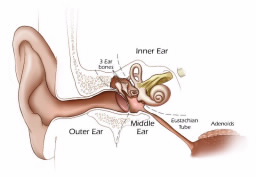FOR IMMEDIATE RELEASE | August 20, 2008
Childhood ear infections may predispose to obesity later in life
PHILADELPHIA, Aug. 20, 2008 — Researchers are reporting new evidence of a possible link between a history of moderate to severe middle ear infections in childhood and a tendency to be overweight later in life. Their study suggests that prompt diagnosis and treatment of middle ear infections — one of the most common childhood conditions requiring medical attention — may help fight obesity in some people. The findings were presented today at the 236th National Meeting of the American Chemical Society (ACS).
Study leader Linda M. Bartoshuk, Ph.D., noted that chronic, repeated ear infections can damage the chorda tympani nerve, which passes through the middle ear and controls taste sensations. Damage to this nerve appears to intensify the desire for fatty or high-energy foods, which could result in obesity, she said.
Contact
215-418-2407 (Philadelphia, Aug. 17-21)
202-872-4400 (Washington D.C.)
Other research has shown that middle ear infections, or otitis media, are becoming more common in children. Childhood obesity is likewise on the rise and has reached epidemic levels, particularly in the United States. Although scientists have known for years that ear infections can lead to hearing loss in children that can result in speech and language impairment, a possible link between ear infections and obesity has been largely unexplored until now, said Bartoshuk, who is with the University of Florida’s Center for Smell and Taste in Gainesville.
In the new study, scientists reviewed data collected from 245 patients (age 30 and older) with a history of middle ear infections and 1,055 patients with no such history. The study included questions about the patients’ dietary preferences among a set of 26 common foods and beverages ranging from low-fat to fatty foods. The researchers found that those with a history of ear infections were more likely to report a higher, more intense preference for fatty foods than others and were twice as likely to be obese.
“The more energy dense a food is, the more a person with ear infections likes it. You can see what that would do to weight gain,” says Bartoshuk. “This finding gives a new environmental component to the obesity problem that allows a possibility of intervention.”
Bartoshuk emphasizes, however, that the findings are preliminary, with much to be learned about the percentage of children with ear infections who are vulnerable to obesity, how much nerve damage must occur before obesity begins, and how frequently the damage must occur, she says. The possible link between nerve damage in the ear, taste preference, and obesity is a complex problem that is just beginning to be explored, says Bartoshuk, a renowned expert on the study of taste.
“We need to study larger numbers of people and do taste-testing on them to find out more about this possible connection,” she says, adding that the research is underway.
The study was funded primarily through the National Institute on Deafness and Other Communication Disorders (NIDCD), one of the National Institutes of Health.
# # #
— Mark T. Sampson
Linda M. Bartoshuk, Ph.D., is a psychologist with the University of Florida’s Center for Smell and Taste in Gainesville, Fla.


